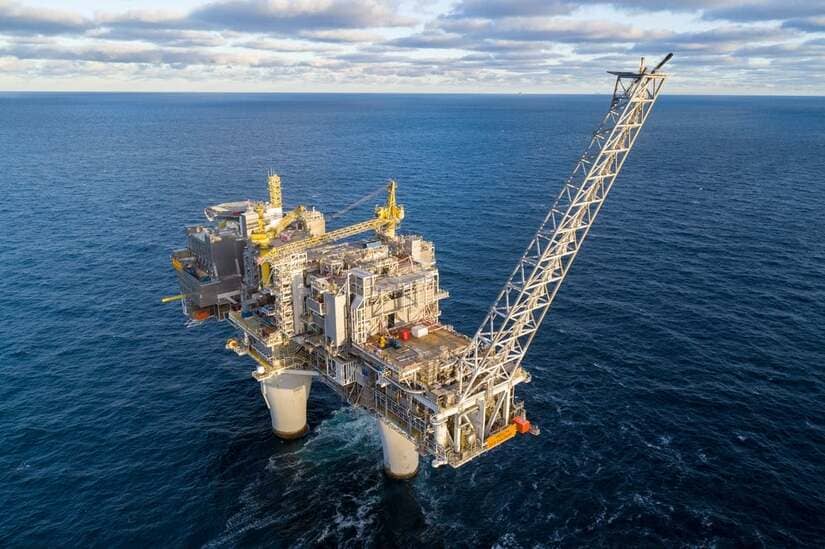Oil and gas production in Norway is expected to rise to record levels in 2023, serving Europe’s aspirations to rely on the country to compensate for the lack of Russian supplies.
And the Norwegian Oil Directorate revealed – today, Monday, January 9 (2023) – that Norwegian oil production is expected to increase by 6.9% this year, thanks to production from the Johan Sverdrup field.
Forecasts showed that the production of crude oil and other oil liquids such as condensate is likely to rise to 2.02 million barrels per day in 2023, from 1.89 million last year (2022), according to information seen by the specialized energy platform.
The country’s gas production is expected to remain virtually unchanged in 2023 at 122 billion cubic metres, or 2.1 million barrels per day of oil equivalent, the directorate confirmed, in line with recent government projections.
Oil and gas investments in Norway
The Norwegian Oil Directorate said – in a statement – that investment by oil and gas producers – including exploration – is expected to rise to 189 billion Norwegian kroner ($19.1 billion) in 2023.
Oil and gas investment in Norway is expected to peak at 202 billion kroner ($20.4 billion) in 2025, up from 172 billion kroner ($17.3 billion) in 2022, Reuters reported.
Commenting on this, Director General of the Oil Directorate, Torgeir Stordal, said: “This will help ensure that Norway continues to be a reliable supplier of energy to Europe.”
The total volume of oil and gas production in Norway is expected to rise to 4.12 million barrels per day of oil equivalent in 2023, up from 3.99 million barrels last year, according to the directorate’s forecast.
Total Norwegian production will continue to rise in the coming years, reaching a two-decade high of 4.3 million barrels in 2025, just below the record high of 4.54 million barrels produced in 2004, the directorate projected.
Norwegian gas exports
In a related context, Norwegian Minister of Oil and Energy Terje Asland said that his country plans to export about 122 billion cubic meters of natural gas in 2023, in line with last year’s level.
Gas shipments from the Norwegian continental shelf for 2022 are up 8% from 2021, matching an all-time high of 122.37 bcm in 2017.
“Norwegian authorities have updated estimates of gas sales from the Norwegian continental shelf in 2023. The estimate is 122 bcm, which is the same level for 2022,” Asland said.
He pointed out that “122 billion standard cubic meters correspond to approximately 1355 terawatt hours. These huge amounts of energy are important for access to European energy and its security,” according to what was reported by the “Offshore Energy” platform.
The following chart – prepared by the specialized energy platform – shows net LNG exports to Europe and Asia:
Gas production forecasts in Norway
As gas producers on the Norwegian continental shelf made a “tremendous effort” to provide “as much gas as possible” to their customers in Europe over the past year (2022), the Norwegian government has confirmed that it expects this effort to continue into 2023.
While there is always uncertainty about the level of production in the future, and this uncertainty increases over time, Norway believes that the current high level of gas production can be maintained over the next 4 to 5 years, said Norwegian Oil Minister Terje Asland.
This expectation is justified by the many ongoing and new development projects on the Norwegian continental shelf, as new investment projects continue to keep the production level constant, according to the Norwegian authorities.
“I am impressed and grateful for the work that has been done in the fields to increase gas shipments to Europe, and for the great efforts of everyone in the industry,” Asland said.
Gas discoveries in Norway
Norway, Europe’s largest supplier, mainly delivers gas to receiving terminals in Britain, Germany, France and Belgium, and in late 2022 it also opened a new pipeline to Poland via Denmark.
It also shipped more liquefied natural gas by tanker from the Hammerfest terminal, which resumed operations in May 2022, after being idle since a fire broke out in 2020.
Equinor and other oil companies in Norway have sought to increase their gas production, as the war in Ukraine caused an energy crisis and soared prices in Europe, according to Reuters.
Multiple discoveries have been announced over the past year (2022), but Far Energy reported at the end of December that it had made what it describes as “the biggest discovery of the year” in the Goliath region of the Barents Sea off the coast of Norway.
Several new projects have come online in 2022, the latest confirmed in mid-December 2022, when Equinor announced the start of production from the Johan Sverdrup Phase 2 project in the North Sea off Norway.
It is expected that the majority of oil and gas production from this field will go to Europe, which will enhance its energy security.
related topics..
Also read..

Leave a Reply